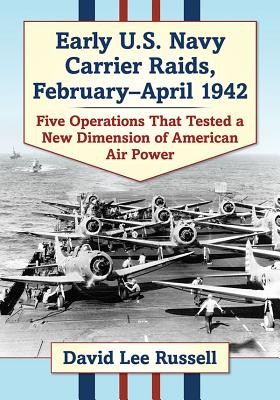
- We will send in 10–14 business days.
- Author: David Lee Russell
- Publisher: McFarland & Company
- ISBN-10: 1476678464
- ISBN-13: 9781476678467
- Format: 17.8 x 25.4 x 1 cm, minkšti viršeliai
- Language: English
- SAVE -10% with code: EXTRA
Early U.S. Navy Carrier Raids, February-April 1942 (e-book) (used book) | bookbook.eu
Reviews
Description
After the Japanese attack on Pearl Harbor, America's fast carrier task forces, with their aircraft squadrons and powerful support warships, went on the offensive. Under orders from Fleet Admiral Ernest J. King, the newly appointed Admiral Chester W. Nimitz, as the Commander-in-Chief of the Pacific Fleet, took the fight to the Japanese, using island raids to slow their advance in the Pacific. Beginning in February 1942, a series of task force raids led by the carriers USS Enterprise, USS Yorktown, USS Lexington and USS Hornet were launched, beginning in the Marshall Islands and Gilbert Islands. An attempted raid on Rabaul was followed by successful attacks on Wake Island and Marcus Island. The Lae-Salamaua Raid countered Japanese invasions on New Guinea. The most dramatic was the unorthodox Tokyo (Doolittle) Raid, where 16 carrier-launched B-25 medium bombers demonstrated that the Japanese mainland was open to U.S. air attacks. The raids had a limited effect on halting the Japanese advance but kept the enemy away from Hawaii, the U.S. West coast and the Panama Canal, and kept open lines of communications to Australia.
EXTRA 10 % discount with code: EXTRA
The promotion ends in 23d.08:22:17
The discount code is valid when purchasing from 10 €. Discounts do not stack.
- Author: David Lee Russell
- Publisher: McFarland & Company
- ISBN-10: 1476678464
- ISBN-13: 9781476678467
- Format: 17.8 x 25.4 x 1 cm, minkšti viršeliai
- Language: English English
After the Japanese attack on Pearl Harbor, America's fast carrier task forces, with their aircraft squadrons and powerful support warships, went on the offensive. Under orders from Fleet Admiral Ernest J. King, the newly appointed Admiral Chester W. Nimitz, as the Commander-in-Chief of the Pacific Fleet, took the fight to the Japanese, using island raids to slow their advance in the Pacific. Beginning in February 1942, a series of task force raids led by the carriers USS Enterprise, USS Yorktown, USS Lexington and USS Hornet were launched, beginning in the Marshall Islands and Gilbert Islands. An attempted raid on Rabaul was followed by successful attacks on Wake Island and Marcus Island. The Lae-Salamaua Raid countered Japanese invasions on New Guinea. The most dramatic was the unorthodox Tokyo (Doolittle) Raid, where 16 carrier-launched B-25 medium bombers demonstrated that the Japanese mainland was open to U.S. air attacks. The raids had a limited effect on halting the Japanese advance but kept the enemy away from Hawaii, the U.S. West coast and the Panama Canal, and kept open lines of communications to Australia.


Reviews